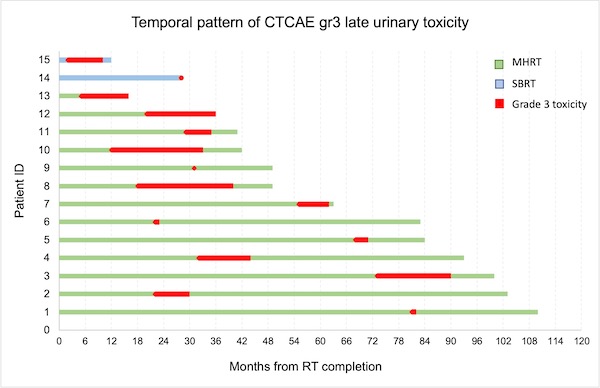Late urinary toxicity with extreme and moderate hypofractionated prostate RT with prior TURP
PD-0572
Abstract
Late urinary toxicity with extreme and moderate hypofractionated prostate RT with prior TURP
Authors: Priyamvada Maitre1, Ketaki Adsul1, Pallavi Singh1, Anuradha Krishnan1, Sarath MS1, Reena Phurailatpam2, Vysakh Raveendran2, Gagan Prakash3, Mahendra Pal3, Vedang Murthy1
1Tata Memorial Centre, Homi Bhabha National Institute, Radiation Oncology, Mumbai, India; 2Tata Memorial Centre, Homi Bhabha National Institute, Medical Physics, Mumbai, India; 3Tata Memorial Centre, Homi Bhabha National Institute, Surgery, Mumbai, India
Show Affiliations
Hide Affiliations
Purpose or Objective
To explore the effect of fraction on late urinary toxicity in prostate cancer patients with prior transurethral resection of prostate (TURP).
Material and Methods
Patients diagnosed with prostate adenocarcinoma and a prior history of TURP, treated with moderate or extreme hypofractionated radiotherapy (MHRT or SBRT), were included for analysis. The incidence and duration of late urinary toxicities were graded as per CTCAE v5.0 using information from clinical records. Proportion of cumulative grade 2 and 3 toxicities were compared for MHRT vs SBRT using chi square test. Impact of potential contributory factors on late urinary toxicity was analysed using univariable and multivariable binary logistic regression analysis.
Results
Total 204 eligible patients were included (MHRT=116, 64-68Gy/25#; SBRT=88, 35-37.5Gy/5#). Median time from TURP to RT was 10 months (IQR 7-16), similar for MHRT and SBRT. Median dose to prostate was 68Gy/25# for MHRT and 36.25Gy/5# for SBRT. Pelvic nodes were treated in 40% patients in both the groups. RT was stopped early due to severe dysuria in 1 patient (SBRT). At a median follow-up of 37 months, cumulative grade 3 late urinary toxicity was 7.4% (n=15), significantly higher in MHRT (11.3% vs 2.2%, p=0.01). Haematuria (9.6% vs 2.2%) and urinary obstruction (4.3% vs 0%) were chief contributory symptoms for higher toxicity with MHRT. Grade 3 toxicity was observed at a median of 28 months (IQR 19-43) after RT completion, and lasted for a median duration of 8 months (IQR 2-14) (Figure 1). Grade 2 toxicity was similar for MHRT and SBRT (24.3% vs 27%, p=0.3), with no significant differences in any of the urinary symptoms. On univariable and multivariable analysis for age, diabetes, pelvic RT, type of hypofractionation, and interval from TURP to RT, MHRT was the only statistically significant factor for cumulative grade 3 toxicity.

Conclusion
In patients with prior TURP, moderate or extreme hypofractionated prostate RT did not result in excessive or long-lasting toxicity.